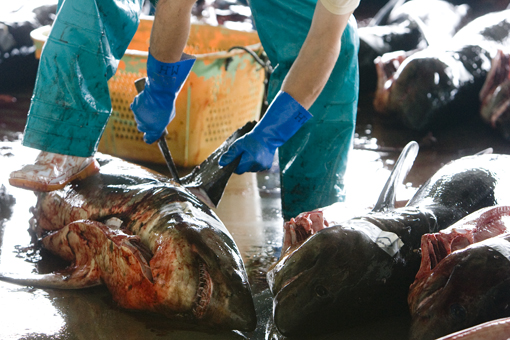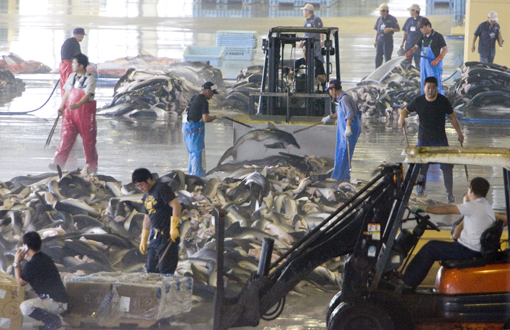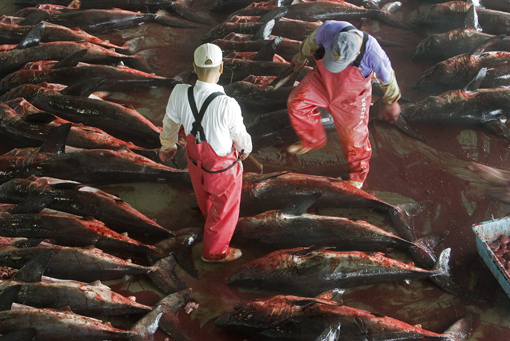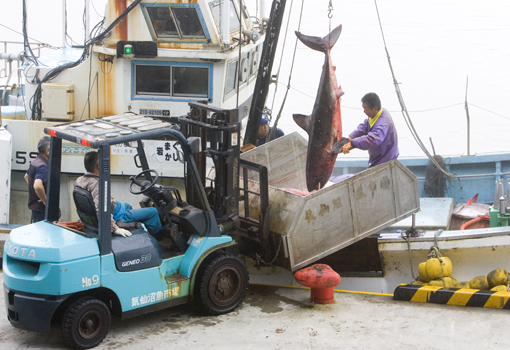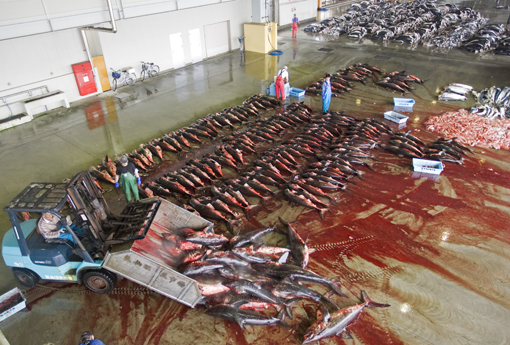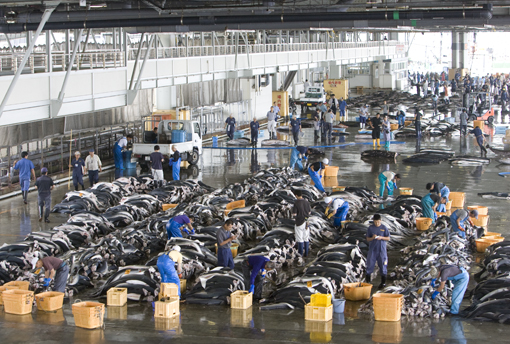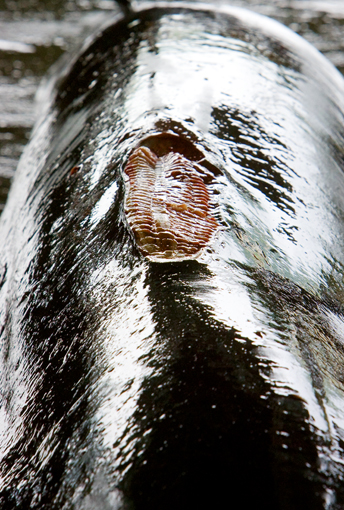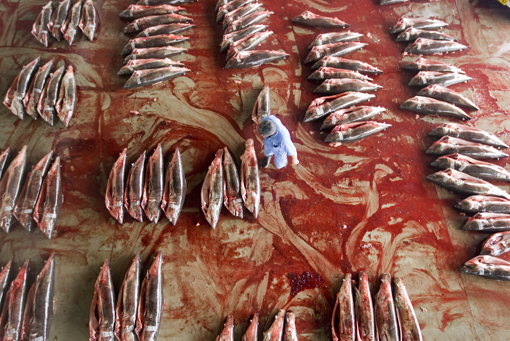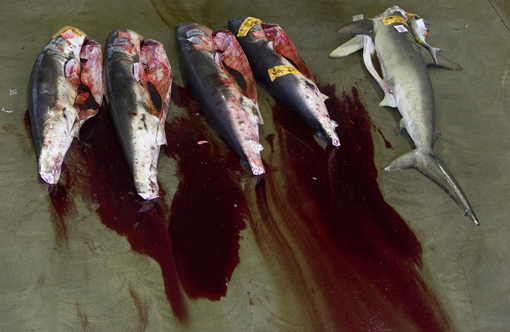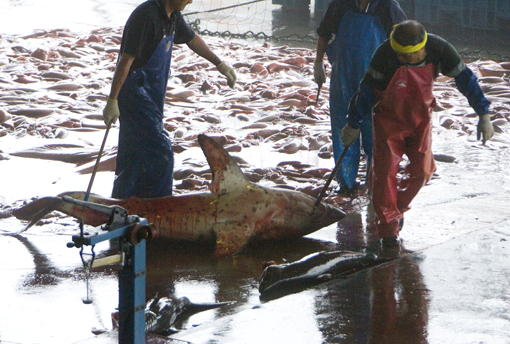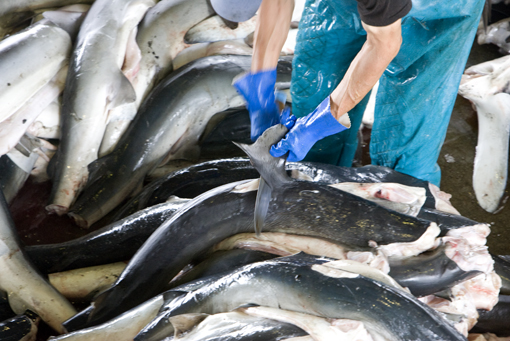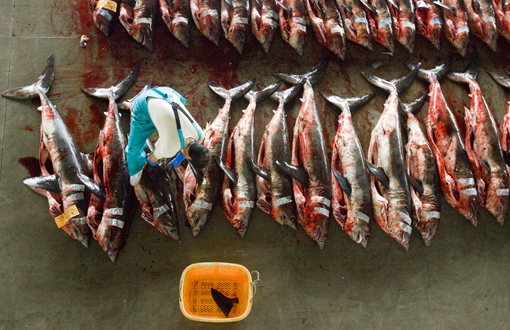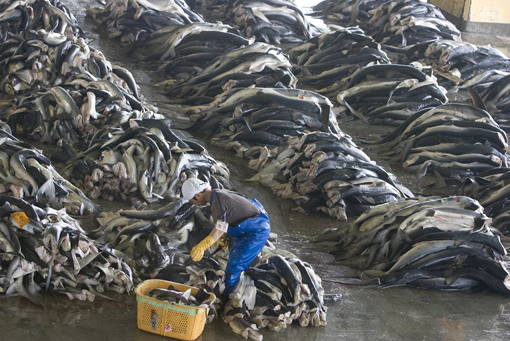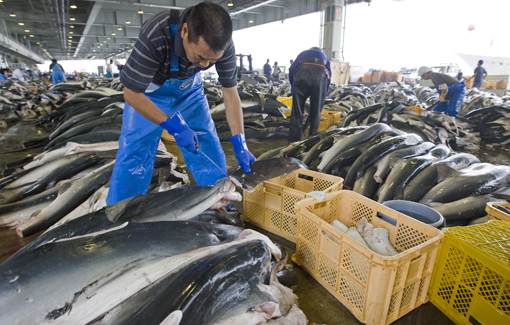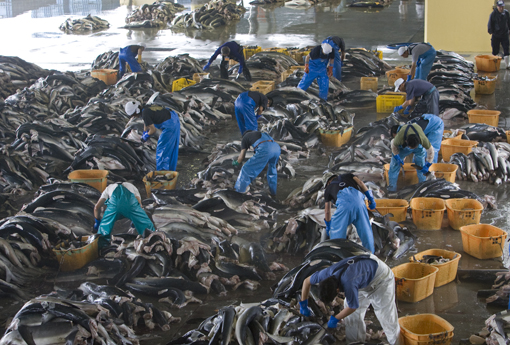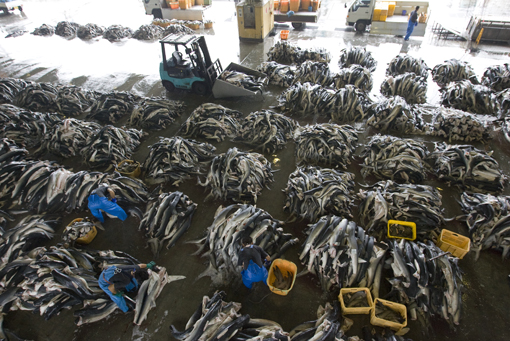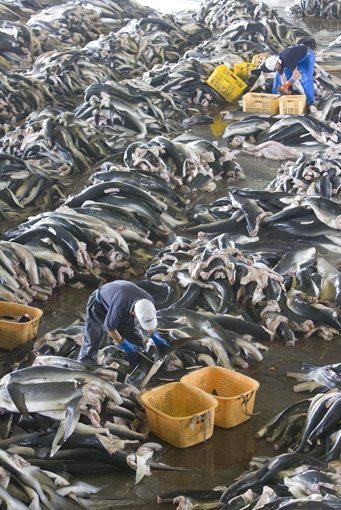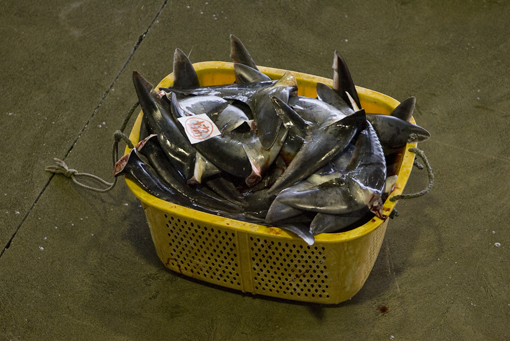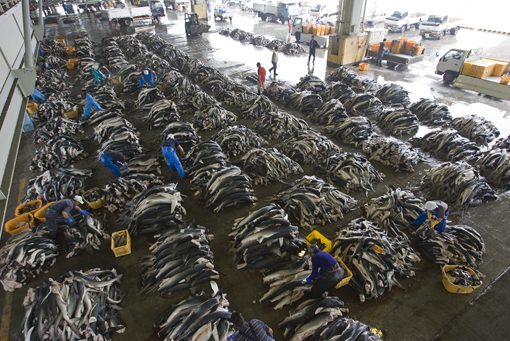
Japan's Shark Fin Capital, Kesen-numa City. This is the picture that sparked a global outcry. (by Alex Hofford)
KESEN-NUMA CITY, JAPAN – It’s 5am on the the north eastern tip of Japan’s main island of Honshu, and 75 tons of dead shark is being meticulously arranged into a neat grid of tidy piles, of twenty sharks per pile.
If you thought shark finning was exclusively a Chinese problem, think again. Welcome to Kesen-numa City, Japan’s shark fin capital.
Here, six days a week, small teams of Japanese workers go about the hushed business of industrial shark-finning.
By 6.30am, with piles arranged, the sharks are disemboweled first. Hearts are ripped efficiently from bodies by men wearing brightly coloured rubber boots and aprons. At 7am, shark corpses are cleaned of their blood by workers wielding water hoses. And by 8am, small teams are silently moving up and down aisles and rows like robots in a Japanese car factory, quickly slicing off every dorsal, pectoral and tail fin from the lifeless, grey lumps. Big hungry black crows squawk in the shadows, looking for bloody morsels. And shark fins plop with regularity into small yellow plastic baskets. The baskets fill up fast, are then weighed, and finally carried to a nearby truck, where a man with a notepad strikes a deal. At 9.30am, it’s all over for another day. Fork lift trucks scoop up tons of limbless carcasses, then dump them into a high-sided truck. The process is a brutal sight to behold, and not for the faint-hearted.
The fishing port of Kesen-numa City is located in Miyagi Prefecture in North East Japan, and is the country’s only port dedicated to catching sharks.
Over two days in early July this year, I saw 119 tons of blue shark (Prionace glaucaof), ten tons of salmon shark (Lamna ditropis), and three tons of short fin mako shark (Isurus oxyrinchus) landed on the dock at Kesen-numa. Not to mention several tons of endangered bluefin tuna, (Thunnus thynnus), but that’s a whole other story. Taking government transparency to another level, landed shark tonnage numbers are provided daily by the port of Kesen-numa’s Japanese only website, which is publicly, (and apparently unashamedly), available.
About half of the shark fin that is processed in Kesen-numa City is destined for China, mainly Hong Kong and Shanghai. For wealthy Chinese, shark fin from Kesen-numa is seen as a premium, or luxury, brand. Mr Hatakeyama, 45, a shark fin processor from Kesen-numa, said, “Quite a bit of shark fin is sent to Shanghai from here as there are many rich people there. Our shark fin here can command higher prices than Chinese shark fin sourced from elsewhere in Asia, the Middle East or Africa. Even though the Chinese have their own shark fin, they prefer Japanese brands”.
Given the delicacy’s roots, this is hardly surprising, but what is more unexpected is that a considerable portion of the shark fin processed in Kesen-numa is bound for domestic consumption. Like in China, shark fin soup is common place at weddings, company banquets and all sorts of other special occasions where the paying host wants to show off their wealth. And much of the shark fin produced at small food factories dotted around the city ends up bound for Chinese restaurants in Japan, of which there are many. The rest is sold to hotels to include on their menus for newly weds and for corporate banquets.
In olden times, shark fin was sometimes used as a substitute for gold when Japanese merchants traded with China. Understandably, and for this same reason, the exact location for fin drying in Japan remains a closely guarded secret. And a significant amount is shipped to China for sun-drying, although the exact drying location in China is an even bigger secret.
These days, the port of Kesen-numa feels like a town down on it’s luck. Once thriving, today there is a sense of decay in the air. Overgrown and rusty. Similarly, attitudes have yet to move with the times. As public sentiment slowly turns against shark fin soup in Hong Kong, what was once an ancient tradition in this forgotten corner of Japan, is, according to conservationists, wreaking havoc on shark populations worldwide. Small fishing boats used catch sharks as part of the city’s ancient tradition.
But this tradition, coupled with modern fishing methods like the advent of strong and long fishing lines, and boats that can go further and stay out of port for longer, is a recipe for disaster for the sharks. According to the Japan Fisheries Agency, the nation’s national shark fin catch nearly halved since the late 1960’s. In 1969, the total number of sharks caught and landed in Japan was around 65,000 tons. Last year’s total was around 35,000 tons, and Kesen-numa accounts for around 90% of all sharks caught nationally.
Whether the global marine ecosystems can suffer such an onslaught is debatable. The arguments against shark-finning are, by now, well known in Hong Kong. It is said that sharks take decades to reach adulthood, and by ripping them out of the oceans at such an unprecedented rate, we are depriving them of them of the chance to reproduce, and thus repopulate their decimated numbers. Cruelty may be the issue at stake for those who see the wasteful practice of slicing the fins off the shark at sea and tossing them back over the side of the boat, but in Kesen-numa the whole shark is landed. It is said that every part of every shark landed at Kesen-numa is processed there and then consumed. Even it’s heart. For the people of Kesen-numa are seen as a little strange by ordinary Japanese. Locals can ill afford the shark fin soup available at many of the town’s small side street restaurants, but the locals have developed a peculiar, if bloodthirsty, fondness for raw salmon shark heart sashimi. An exotic ‘delicacy’, which, according to local people, is consumed nowhere else in Japan. It is left up to the tourists who visit Kesen-numa to order the city’s famous speciality, shark fin soup.
And tourists do come. Some are attracted to the splendid hiking along Miyagi Prefecture’s rugged coastline, whilst others are seafood aficionados, looking for their next hit of sublime ultra-fresh exotic seafood. Early risers among them will inevitably make their way to the dock, where they are confronted with one of the most bloody spectacles they are likely ever to witness in their lives – Kesen-numa’s very own industrial shark-finning show.
A quick walk around the town, reveals a parallel universe, where even the most basic concepts of marine conservation do not exist. Just a stone’s throw from the dock, is the ‘Kesen-numa Rias Shark Museum’, which visitors enter through a giant set of shark jaws. Once inside, tourists are first confronted by real copies of faded front pages of tabloid newspapers from around the world that sensationalize shark attacks on swimmers. Make no mistake, sharks are bad, evil, a threat to humanity and they should be erdaicated from the face of the earth, the headlines, and so it seems the museum’s message screams at us. This despite the fact that humans are statistically far more likely to die from crossing the road, than from an attack by a shark. After passing exhibits relating to the natural history of sharks at the half way mark, visitors leaving the museum pass a glass display box filled with all kinds of products one can make from shark; shark fin soup in a can, shark cartillage pills which are supposedly good for joint pain, and hand-crafted handbags made from shark leather. But not a word about conservation and the critical situation facing global shark stocks due to over-fishing.
Could a new battle between marine conservationists battling to save the sharks and the Japanese fishing lobby be on the horizon? First there was the annual showdown in the Southern Ocean between the Japanese whaling fleet and the environmental groups Greenpeace and Sea Shepherd to save the whale. Then there was the runaway success of the Oscar-winning documentary ‘The Cove’ which exposed the brutal Japanese trade in captive dolphins. One would think the tide is slowly turning.
Isn’t it time Kesen-numa City, Japan’s dirty little shark secret, was shut down too?
Alex Hofford: Hong Kong China Kesennuma Japan shark fin photographer
[source: http://www.alexhoffordphotography.com/node/2333]

